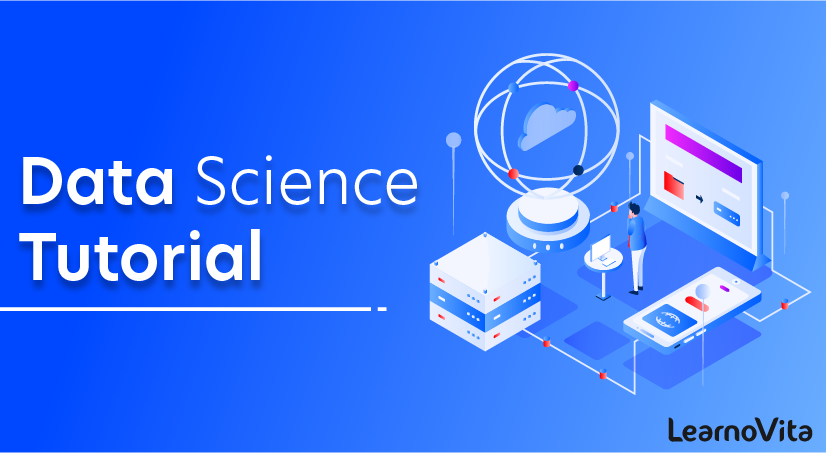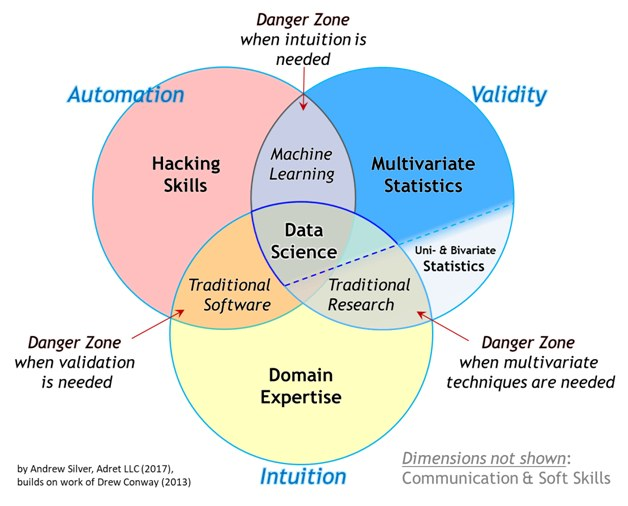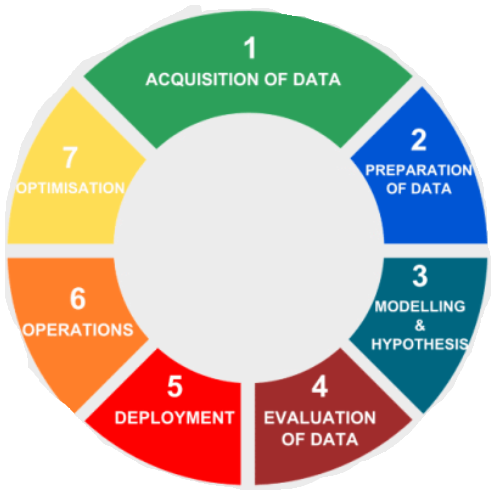
Data Science Tutorial
Last updated on 19th Sep 2020, Blog, Tutorials
“Data Science is about extraction, preparation, analysis, visualization, and maintenance of information. It is a cross-disciplinary field which uses scientific methods and processes to draw insights from data. ” With the emergence of new technologies, there has been an exponential increase in data. This has created an opportunity to analyze and derive meaningful insights from data. It requires special expertise of a ‘Data Scientist’ who can use various statistical & machine learning tools to understand and analyze data. A Data Scientist, specializing in Data Science, not only analyzes the data but also uses machine learning algorithms to predict future occurrences of an event. Therefore, we can understand Data Science as a field that deals with data processing, analysis, and extraction of insights from the data using various statistical methods and computer algorithms. It is a multidisciplinary field that combines mathematics, statistics, and computer science.

Why Data Science?
Companies require data to function, grow and improve their businesses. Data Scientists deal with the data in order to assist companies in making proper decisions. The data-driven approach undertaken by the companies with the help of Data Scientists who analyze a large amount of data to derive meaningful insights. These insights will be helpful for the companies who wish to analyze themselves and their performance in the market. Other than commercial industries, healthcare industries also use Data Science. where the technology is in huge demand to recognize microscopic tumors and deformities at an early stage of diagnosis.
Solving Problems with Data Science
When solving a real-world problem with Data Science, the first step towards solving it starts with Data Cleaning and Preprocessing. When a Data Scientist is provided with a dataset, it may be in an unstructured format with various inconsistencies. Organizing the data and removing erroneous information makes it easier to analyze and draw insights. This process involves the removal of redundant data, the transformation of data in a prescribed format, handling missing values etc.
A Data Scientist analyzes the data through various statistical procedures. In particular, two types of procedures used are:
- Descriptive Statistics
- Inferential Statistics
Assume that you are a Data Scientist working for a company that manufactures cell phones. You have to analyze customers using the mobile phones of your company. In order to do so, you will first take a thorough look at the data and understand various trends and patterns involved. In the end, you will summarize the data and present it in the form of a graph or a chart. You therefore, apply Descriptive Statistics to solve the problem.
You will then draw ‘inferences’ or conclusions from the data. We will understand inferential statistics through the following example – Assume that you wish to find out a number of defects that occurred during manufacturing. However, individual testing of mobile phones can take time. Therefore, you will consider a sample of the given phones and make a generalization about the number of defective phones in the total sample.
Now, you have to predict the sales of mobile phones over a period of two years. As a result, you will use Regression Algorithms. Based on the given historical sales, you will use regression algorithms to predict the sales over time.
Furthermore, you wish to analyze if customers will purchase the product based on their annual salary, age, gender, and credit score. You will use historical data to find out whether customers will buy (1) or not (0). Since there are two outputs or ‘classes’, you will use a Binary Classification Algorithm. Also, if there are more than two output classes we use the Multivariate Classification Algorithm to solve the problem. Both of the above-stated problems are part of ‘Supervised Learning’.
There are also instances of ‘unlabeled’ data. In this, there is no segregation of output in fixed classes as mentioned above. Suppose that you have to find clusters of potential customers and leads based on their socio-economic background. Since you do not have a fixed set of classes in your historical data, you will use the Clustering Algorithm to identify clusters or sets of potential clients. Clustering is an ‘Unsupervised Learning’ algorithm.
Tools for Data Science
- R
- Python
- SQL
- Hadoop
- Tableau
- Weka
Data Science Life Cycle:

The data science life cycle can be set out in the following way:
Subscribe For Free Demo
Error: Contact form not found.
1. The acquisition of data
This is simply the process of acquiring data from internal and external sources.
2. The preparation of Data
Here the data is cleaned and shaped into a usable form. These first two steps are vital for data science to function correctly. A still emerging discipline, data scientists often benefit from working alongside people experienced in understanding data. Typically, once understanding has been achieved the project will begin to resemble an engineering exercise. Consequently, it follows a defined set of rules and exit criteria. This allows data scientists to make informed decisions, allowing for optimisation.
3. Modelling and Hypothesis
This stage is commonly used on statistical samples in data mining. However, in data science, it is applied, via machine learning, to all types of data. It is at this stage of the process that training sets and models are created. Validation or test sets are also produced now.
4. Evaluation and Interpretation of Data
Once modelling has taken place, data is constantly tested, reevaluated and reshaped. Eventually, a usable model is created.
5. Deployment
Once a usable model has been created it is deployed. This is often initially done in a limited or trail form.
6. Operations
Once the model has been optimised it can be rolled out into larger operations. While the model is now being deployed its performance is still monitored and evaluated.
7. Optimisation
While models are now operational they are still constantly improved. The more data a model can work through the more it learns, becoming more refined and capable in the process.
Applications of Data Science
Data science is becoming one of the most demanding fields nowadays and thus used in various areas. There are multiple applications of data science. Let us explore them:
Healthcare Sectors: Healthcare sector is one of the most benefited industries from data science. Data science is used in detecting tumors, artery stenosis, organ description employs various methods and frameworks like Map reduce to find ideal parameters for tasks such as lung texture sorting. It applies machine learning methodologies, support vector machines, content-based medical image indexing, and wavelet analysis for stable texture classification.
Internet Searching: Well, apart from Google there are a lot of search engines such as Yahoo, Bing, Ask, AOL, etc. All these search engines utilize data science algorithms to provide the best outcome for our searched query in a few seconds. Because Google processes more than 20 petabytes of information daily. If there has been no data science, Google wouldn’t have been the one which we know today.
Digital Advertisements: Data science algorithms are also used in digital advertising. Though internet surfing is one of the most significant applications of data science and machine learning, the entire digital marketing spectrum is another application. Data science algorithms are used to display banners on different websites, digital billboards at the airports. That’s why the digital advertisement has been able to obtain a higher CTR than traditional ads.
Fraud and Risk Detection: The first application of data science is started from the Finance discipline. Organizations were exhausted by terrible obligations and misfortunes consistently. Nonetheless, they had a great deal of data which is used to get gathered during the initial paperwork while endorsing credits. They selected to carry data science practices to protect them out of losses. Throughout the years, managing banking organizations figured out how to isolate and defeat data using client profiling, past uses, and other fundamental factors to investigate the probabilities of hazard and default. Besides, it equally helped them to push their banking items dependent on the client’s buying power.
Airline Route Planning: Airline Industry over the world is known to hold up under overwhelming misfortunes. But a couple of airline service providers, organizations are attempting to keep up their occupancy proportion and working benefits. With skyscrapers in air-fuel costs and need to offer substantial limits to clients have additionally exacerbated things. It wasn’t for long when airlines began utilizing data science to distinguish the vital territories of enhancements. Presently, with the help of data science, the aircraft organizations can:
- Forecast the delay in flights.
- Decide which class of planes to purchase
- Whether to accurately arrive at the goal, or take a stop in the middle of (For instance: A flight can have an immediate route from New Delhi to New York. On the other hand, it can also stop in any nation.)
- Effectively drive client faithfulness programs
Southwest Airlines, Alaska Airlines are among the best organizations that have included data science to bring changes in their manner of working.
Gaming: Data science is also used in gaming. With the help of data science EA sports, Zynga, Sony, Nintendo, Activision-Blizzard have managed the gaming skill to the next level. Presently, most of the games are designed using machine learning algorithms which enhance themselves as the player’s transfers up to an advanced degree. Also, in motion gaming, your challenger can investigate your past moves and then shapes up its games accordingly.
Image Recognition: Another application of data science can be seen in the image recognition field. To understand this, let’s take an example, you upload your pics with friends on Facebook then you start getting ideas to tag your friends. This automatic tag suggestion feature is carried out by using the face recognition algorithm. In a similar manner, when using web WhatsApp, you scan a barcode in your web browser using your cell phone. Additionally, Google offers you the option to search for images by uploading them. It utilizes image recognition algorithms and gives relevant search outcomes.
Logistics Delivery: Data science is also used in logistics companies such as DHL, FedEx, UPS to enhance their operational efficiency. With the help of data science, these companies have found out the best way to ship, the most appropriate time to deliver, the best method of transport to pick subsequently prompting cost-effectiveness, and a lot more to make refer to. Moreover, the data that these organizations produce utilizing the GPS introduced, gives them a lot of likely outcomes to investigate utilizing data science.
Speech Recognition: Similar to image recognition application, data science algorithms are also used in speech recognition. Few of the best examples of speech recognition products are Google Voice, Siri, Cortana, etc. If you are not able to type any message, it is possible to send the message with the help of speech recognition feature. You have to speak out the message, and it will convert into text.
Price Comparison Websites: At a fundamental dimension, the price comparison websites are being determined by lots, and lots of data which is fetched using APIs and RSS feeds. If you have ever utilized these sites, you would know the accommodation of looking at the cost of an item from numerous sellers at one single place. Few examples of price comparison websites are PriceGrabber, PriceRunner, Junglee, Shopzilla, Deal Time, etc. Presently, the price comparison websites are found in every place, for example, innovation, accommodation, automobiles, durables apparels, etc.
Advantages of Data Science
- Data Science helps organizations know how and when their products sell best and that’s why the products are always delivered to the right place and right time.
- Faster and better decisions are taken by the organization to improve efficiency and earn higher profits.
- It helps the marketing and sales team of organizations in understanding by refining and identifying the target audience.
Disadvantages of Data Science
- Extracted information from the structured as well as unstructured data for further use can also be misused against a group of people of a country or some committee.
- Tools used for data science and analytics are more expensive to use to obtain information. The tools are also more complex, so people have to learn how to use them.
Comparison of Data Science with Data Analytics
A lot of people confuse the role of a Data Scientist with the role of a Data Analyst. So, we will go ahead and understand the similarities and differences between Data Science and Data Analytics in this Data Science tutorial.
| Criteria | Data Science | Data Analytics |
|---|---|---|
| Skills Needed | Data capturing, statistics, and problem-solving | Analytical, mathematical, and statistical skills |
| Type of Data Used | All types of data | Mostly structured and numeric data |
| Standard Life Cycle | Explore, discover, investigate, and visualize | The report, predict, prescribe, and optimize |
The above table gives you a high-level understanding of what the major difference is between a Data Scientist and a Data Analyst. One more key difference between the two domains is that data analysis is a necessary skill for Data Science. Thus, Data Science can be thought of as a big set, where data analysis can be a subset of it.
Types of Data Science Jobs
Various job roles in the domain of Data Science are listed as below:

Data Analyst
A Data Analyst is entrusted with the responsibility of mining huge amounts of data, looking for patterns, relationships, trends, and so on, and coming up with compelling visualization and reporting for analyzing the data to make business decisions.
Data Engineer
A Data Engineer is entrusted with the responsibility of working with large amounts of data. He/she should be available to clear data cleansing, data extraction, and data preparation for businesses for working with large amounts of data.
Machine Learning Expert
A Machine Learning expert is the one who is working with various Machine Learning algorithms like regression, clustering, classification, decision tree, random forest, and so on.
Data Scientist
A Data Scientist is the one who works with huge amounts of data to come up with compelling business insights through the deployment of various tools, techniques, methodologies, algorithms, and so on.
Top 15 data science certifications
- Certified Analytics Professional (CAP)
- Cloudera Certified Associate: Data Analyst
- Cloudera Certified Professional: CCP Data Engineer
- Data Science Council of America (DASCA) Senior Data Scientist (SDS)
- Data Science Council of America (DASCA) Principle Data Scientist (PDS)
- Dell EMC Data Science Track
- Google Certified Professional Data Engineer
- Google Data and Machine Learning
- IBM Data Science Professional Certificate
- Microsoft MCSE: Data Management and Analytics
- Microsoft Certified Azure Data Scientist Associate
- Open Certified Data Scientist (Open CDS)
- SAS Certified Advanced Analytics Professional
- SAS Certified Big Data Professional
- SAS Certified Data Scientist
Are you looking training with Right Jobs?
Contact Us- What is Data Science?
- Top Data Science Books for Beginners and Advanced Data Scientist
- Why Python Is Essential for Data Analysis and Data Science
- What are the Analytical Skills Necessary for a Successful Career in Data Science?
- Google Data Science Interview Questions and Answers
Related Articles
Popular Courses
- Artificial Intelligence Course
11025 Learners - Machine Learning Online Training
12022 Learners - Python Online Training
11141 Learners
- What is Dimension Reduction? | Know the techniques
- Difference between Data Lake vs Data Warehouse: A Complete Guide For Beginners with Best Practices
- What is Dimension Reduction? | Know the techniques
- What does the Yield keyword do and How to use Yield in python ? [ OverView ]
- Agile Sprint Planning | Everything You Need to Know
